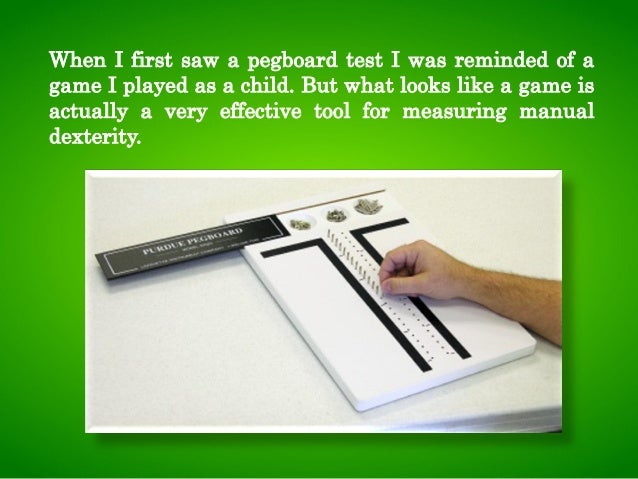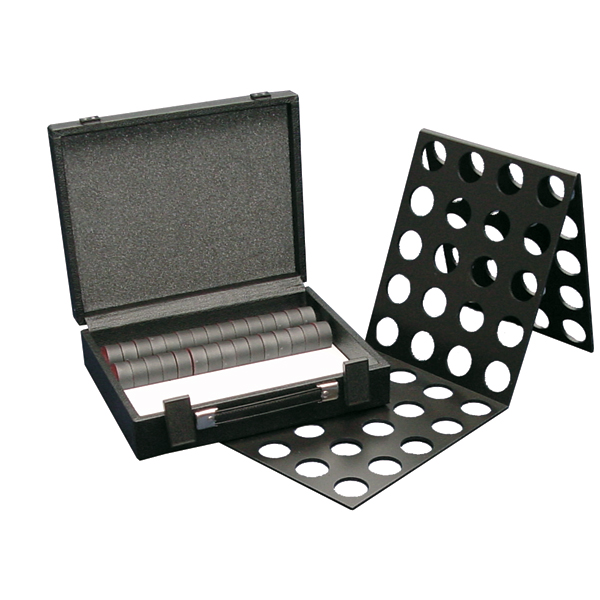FedEx and UPS Ground Delivery Days Approximate
- Northwest 1-3 days
- Southwest 3-4 days
- Midwest 3-4 days
- Northeast 5-6 days
- Southeast 5-6 days
Expedited Shipments
QuickMedical offers the ability to ship 'In Stock', Next Day Air, 2nd Day Air, and 3rd Day Air.
Feb 21, 2011 Best Answer: It depends on the exact form of the test; basically, this test measures your hand-eye coordination and gross motor skills. You might be asked to put 64 checkers on a checkerboard, then sort them red on one side, black on the other. Then maybe turn the all upside down. You could get a. The Minnesota Manual Dexterity Test (MMDT) is a frequently administered, standardized test for the evaluation of a subject’s ability to move small objects various distances. This manual is a guide demonstrating the proper test procedure for each test battery. The test administrator must read and follow the manual completely to insure that stand.
Note: Weekends and holidays are not considered travel days (UPS will not deliver on the weekend). Expedited orders shipped on Friday: UPS Next Day shipped on Friday will be delivered Monday; 2nd Day Air will be delivered on Tuesday; 3rd Day Air delivered on Wednesday. FedEx delivers residential shipments on Saturday but not on Monday.

On Fridays only, UPS Next Day Saturday delivery might be available in your area: please call our Customer Service department at (888) 345-4858 for more details.
Due to possible technical or human error, QuickMedical cannot guarantee the ship day or delivery day on any expedited shipment. We recommend that you call and consult with our Customer Service department to verbally communicate all expedited shipping requirements. We can be reached at (888) 345-4858.
Factory Direct
Some products ship 'Factory Direct', meaning your items may be shipped to you directly from the manufacturer's factory and not from the QuickMedical warehouse: we will do everything possible to have the factory ship your order as requested; however, we cannot guarantee that the factory will be able to meet your specific deadlines. After placing your order online, we highly recommend that you call our Customer Service department about your delivery requirements at (888) 345-4858.
UPS will not ship to a Post Office Box.
| Purdue Pegboard Test | |
|---|---|
| Medical diagnostics |
The Purdue Pegboard Test is a neuropsychological test of manual dexterity and bimanual coordination.[1] The test involves two different abilities: gross movements of arms, hands, and fingers, and fine motor extremity, also called 'fingerprint' dexterity.[2] Poor Pegboard performance is a sign of deficits in complex, visually guided, or coordinated movements that are likely mediated by circuits involving the basal ganglia.[3]
- 2Method and interpretation
History[edit]
Dr. Joseph Tiffin, an Industrial Psychologist at Purdue University, designed the test in 1948. It was originally intended for assessing the dexterity of assembly line workers.[4]

Test For Manual Dexterity
Method and interpretation[edit]
The pegboard consists of a board with two parallel rows with 25 holes into which cylindrical metal pegs are placed by the examinee. The test involves a total of four trials.[5] To begin, there is a brief practice. The subsets for preferred, non-preferred, and both hands require the patient to place the pins in the holes as quickly as possible, with the score being the number of pins placed in 30 seconds.

Neurocognitive disorders[edit]
The Purdue Pegboard test predicted worse adult tic severity and correlated with tic severity at the time of childhood assessment.
Purdue Pegboard performance deficiencies have been linked to poor social functioning in schizophrenia.
Minnesota Manual Dexterity Test
Industry[edit]
Results from a correlation analysis suggested that a person's capability on the Purdue Pegboard Test is a good predictor of their ability to use a mobile phone in cold weather.[6]
Reliability[edit]
One-trial administration of the Purdue Pegboard Test produced test-retest reliability of 0.60 to 0.79. The three-trial administration test-retest reliability ranged from 0.82 to 0.91.[4]
Manual Dexterity Test Definition
References[edit]
- ^Esther Strauss (2006). A Compendium of Neuropsychological Tests: Administration, Norms, and Commentary. Oxford University Press. pp. 1042–. ISBN978-0-19-515957-8. Retrieved 19 August 2013.
- ^Jack M. Guralnik; Linda P. Fried; Eleanor M. Simonsick; Judith D. Kasper; Mary E. Lafferty (1 July 1995). The Women's Health and Aging Study: Health and Social Characteristics of Older Women With Disability. DIANE Publishing. pp. 39–. ISBN978-0-7881-3122-6. Retrieved 19 August 2013.
- ^Davide Martino; James F. Leckman (9 May 2013). Tourette Syndrome. Oxford University Press. pp. 113–. ISBN978-0-19-979626-7. Retrieved 19 August 2013.
- ^ abMary Vining Radomski; Catherine A. Trombly Latham (2008). Occupational Therapy for Physical Dysfunction. Lippincott Williams & Wilkins. pp. 1140–. ISBN978-0-7817-6312-7. Retrieved 19 August 2013.
- ^Patricia Espe-Pfeifer; Jana Wachsler-Felder (30 April 2000). Neuropsychological Interpretations of Objective Psychological Tests. Springer. pp. 26–. ISBN978-0-306-46224-5. Retrieved 19 August 2013.
- ^Patrick Langdon; John Clarkson; Peter Robinson (28 February 2010). Designing Inclusive Interactions: Inclusive Interactions Between People and Products in Their Contexts of Use. Springer. pp. 33–. ISBN978-1-84996-166-0. Retrieved 19 August 2013.